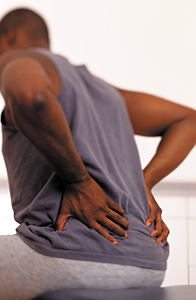We all have heard/read that low back pain has a dramatic influence on our economy. It leads to lost productivity, disability and increased health care costs. The prevalence of low back pain in the working population ranges from 15 percent to 34 percent, depending on the country.1 Once a patient suffers from low back pain, it is not uncommon for them to suffer additional bouts thereafter.
The Myth That Low Back Pain Resolves Quickly
When I was in chiropractic college, I was told by older students and some doctors that pain goes away quickly and patients will leave my practice, never to be seen again. I am still told this today by students and some doctors. It is important to understand that this notion about a rapidly developing and sustained pain-free state is more opinion than fact. Croft, et al., examined this issue back in the late 1990s and provided us with the following key messages:2
- It is widely believed that 90 percent of episodes of low back pain seen in general practice resolve within one month.
- A large population-based study examined the outcome of episodes of low back pain in general practice with respect to both consultation behavior and self-reported pain and disability. While 90 percent of patients consulting general practice with low back pain ceased to consult about the symptoms within three months, most still had substantial low back pain and related disability. Only 25 percent of the patients who consulted about low back pain had fully recovered 12 months later.
- Since most patients continue to have long-term low back pain and disability, effective early treatment could reduce the burden of these symptoms and their social, economic, and medical impact.
 In summary, 90 percent of patients with low back pain are not pain-free within a month; instead, some 75 percent still have pain after one year. Because pain is typically cyclic or chronic, we need to be better at helping patients to become pain-free or less encumbered by their pain. Several excellent texts and articles have been authored by chiropractors on this subject.3-8
In summary, 90 percent of patients with low back pain are not pain-free within a month; instead, some 75 percent still have pain after one year. Because pain is typically cyclic or chronic, we need to be better at helping patients to become pain-free or less encumbered by their pain. Several excellent texts and articles have been authored by chiropractors on this subject.3-8
Pain Is Synonymous With a Lack of Wellness
A recent paper sought to examine the functional limitations of pain on male and female subjects age 50 or older.9 Four functional domains were considered including mobility (ability to walk or jog), stair climbing, upper extremity tasks, and general activities of daily living. Subjects with pain at age 50 had the functional capacity of 80-year-old subjects who did not have pain.
I live in Florida and observe many older individuals moving about in stores and at the beach. Most of the happy, pain-free 80-year-olds are not out jogging. Only 4 percent of subjects 80-89 years of age in this study were able to jog a mile, 55 percent were able to walk several blocks without difficulty, and 72 percent were able to walk one block without difficulty. These functional abilities were nearly identical for 50-59-year-olds with pain.
I commonly hear people with aches and pains in their 50s state: "I feel like I am in my 80s." Turns out that they are making an accurate statement. We also now know that people who develop a new onset of low back pain have increased health expenditures for other conditions after the back pain develops.1 Clearly, being pain-free should be our collective goal if we want to be functional and active as we age and have less health care expenditures. It turns out that the road to being pain-free requires us to engage in wellness behaviors.
Lack of Wellness Promotes Pain Expression
As mentioned above, in the late 1990s researchers discovered that some 75 percent of low back pain patients were still in pain 12 months after their initial consultation.2 The same group of researchers sought to identify factors that were associated with disabling low back pain at 12 months.10 Multiple lifestyle factors were identified, which the authors referred to as premorbid factors:
- High levels of psychological distress
- Poor self-rated health
- Low levels of physical activity
- Smoking
- Dissatisfaction with employment
- Pain-related factors - duration of symptoms, pain radiating into the leg, and widespread pain
- Restriction in spinal mobility
Interestingly, Leboeuf-Yde, et al., identified a similar history profile for patients who would not respond favorably to spinal adjusting by the fourth adjustment. Additional treatments turned out not to be beneficial if the patient was not pain-free by visit four and had the following predictive factors:11
- A female receiving some sort of social benefit
- Moderate or severe pain
- Pain at the first consultation has been continuous for at least six months
- Persistent neck pain in the past year
More recently, Mintken, et al., identified predictive factors for patients with shoulder pain who would respond to manipulation,12 one of which was "not taking medications for their shoulder pain." This suggests that manipulation responders were not inflamed enough to warrant the use of medication.
In summary, multiple "unwellness" factors are found in subjects with chronic pain. This allows us to create a wellness program for patients based on addressing these factors.
A Wellness Plan Based on the Profile of a Chronic Pain Patient
The patients in your practice not likely to respond to manual care are those with chronic back pain with the following profile: They are stressed out, have low self-rated health, don't exercise, don't like their jobs, regularly take NSAIDs, and tend to smoke. With these in mind, we can craft a wellness plan that encourages self-efficacy and gives patients the best chance for recovery. This plan includes the following:
- Quit smoking if a current smoker.
- Accept current job while engaging in activities to find new, more satisfying work
- If unemployed and receiving social benefits, actively engage employment opportunities with a positive outlook.
- Begin to exercise. Walking 30 minutes per day is a great start along with spinal stabilization exercises.
- Get adequate sleep/rest.
- Embrace a stress management program to develop a more positive outlook.
- Eat anti-inflammatory foods, take anti-inflammatory supplements and transition off chronic NSAID use.13-14
References
- Nimgade A, McNeely E, Milton D, Celona J. Increased expenditures for other health conditions after an incident of low back pain. Spine, 2010;35(7):769-77.
- Croft PR, Macfarlane GJ, Papageorgiou AC, Thomas E, Silman AJ. Outcome of low back pain in general practice: a prospective study. Brit Med J, 1998;316:1356-59.
- Souza TA. Differential Diagnosis and Management for the Chiropractor, 4th Edition. Boston: Jones & Bartlett; 2009.
- Liebenson CL, Ed. Rehabilitation of the Spine: A Practitioner's Manual. Baltimore: Williams & Wilkins; 2006.
- Morris CE, Ed. Low Back Syndromes: Integrated Clinical Management. New York: McGraw Hill; 2006.
- Murphy DR, Hurwitz EL. A theoretical model for the development of a diagnosis-based clinical decision rule for the management of patients with spinal pain. BMC Musculoskelet Disord, 2007;8:75.
- Murphy DR, Hurwitz EL, McGovern EE. Outcome of pregnancy-related lumbopelvic pain treated according to a diagnosis-based decision rule: a prospective observational cohort study. J Manipulative Physiol Ther, 2009;32(8):616-24.
- Murphy DR, Hurwitz EL, McGovern EE. A nonsurgical approach to the management of patients with lumbar radiculopathy secondary to herniated disk: a prospective observational cohort study with follow-up. J Manipulative Physiol Ther, 2009;32(9):723-33.
- Covinsky KE, Lindquist K, Dunlop DD, Yelin E. Pain, functional limitations, and aging. J Am Geriatr Soc, 2009;57:1556-61.
- Thomas E, Silman AJ, Croft PR, Papageorgiou AC, Jayson MI, Macfarlane GJ. Predicting who develops chronic low back pain in primary care: a prospective study. Brit Med J, 1999;318:1662-67.
- Leboeuf-Yde C, Grovstvedt A, Borge JA, et al. The Nordic Back Pain Subpopulation Program: demographic and clinical predictors for outcome in patients receiving chiropractic treatment for persistent low back pain. J Manipulative Physiol Ther, 2004;27(8):493-502.
- Mintken PE, Cleland JA, Carpenter KJ, Bieniek ML, Keirns M, Whitman JM. Some factors predict short-term outcomes in individuals with shoulder pain receiving cervicothoracic manipulation: a single arm trial. Phys Ther, 2010;90:26-42.
- Seaman DR. "The Unique Expression of Inflammation in Your Practice." Dynamic Chiropractic, April 9, 2010.
- Seaman DR."Staying Healthy During Tough Economic Times." Nutritional Wellness, February 2009.
Click here for more information about David Seaman, DC, MS, DABCN.





